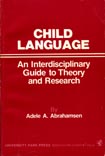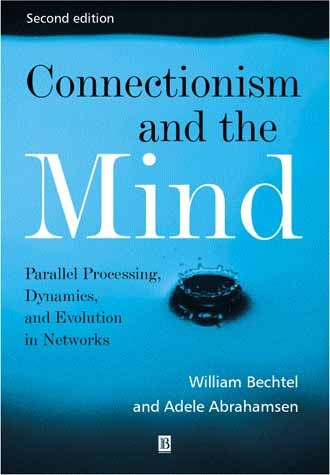





Abrahamsen, A. A. (1977). Child language: An interdisciplinary guide to theory and research. Baltimore: University Park Press. (381 pages).
Bechtel, W., & Abrahamsen, A. A. (1991). Connectionism and the mind: An introduction to parallel processing in networks. Oxford: Blackwell. Translated into French, 1993.
Bechtel, W., & Abrahamsen, A. A. (2002). Connectionism and the mind: Parallel processing, dynamics, and evolution in networks (Second Edition). Oxford: Blackwell.
Abrahamsen, A. Sheredos, B, and Bechtel, W. (2018). Explaining visually using mechanism diagrams. In Glennan, S. and Illari, P. The Routledge Handbook of Mechanisms and Mechanical Philosophy (pp. 238-254). London: Routledge.
Bechtel, W., Abrahamsen, A. and Sheredos, B. (2018). Using diagrams to reason about biological mechanisms. P. Chapman, G. Stapleton, A. Moktefi, S. Perez-Kriz, and F. Bellucci (Eds.). Diagrammatic representation and inference (pp. 264-279). Cham, Switzerland: Springer International Publishing.
Burnston, D. C., Sheredos, B., Abrahamsen, A., & Bechtel, W. (2014). Scientists' use of diagrams in developing mechanistic explanations: A case study from chronobiology. Pragmatics and Cognition, 22(2), 224-243.
Abrahamsen, A. and Bechtel, W. (2015). Diagrams as tools for scientific reasoning. Reviews of Philosophy and Psychology, 6, 117-131.
Bechtel, W., Sheredos, B., Burnston, D., and Abrahamsen, A. (2014). Representing time in scientific diagrams. Proceedings of the 36th Annual Conference of the Cognitive Science Society. Austin, TX: Cognitive Science Society.
Sheredos, B., Burston, D. C., Abrahamsen, A, and Bechtel, W. (2013). Why do biologists use so many diagrams? Philosophy of Science, 80, 931-944.
Bechtel, W. and Abrahamsen, A. (2013). Roles of diagrams in computational modeling of mechanisms. Proceedings of the 35th Annual Conference of the Cognitive Science Society. Austin, TX: Cognitive Science Society, pp. 1839-1844.
Bechtel, W. and Abrahamsen, A. (2013). Thinking dynamically about biological mechanisms: Networks of coupled oscillators. Foundations of Science, 18, 707-723.
Bechtel, W. and Abrahamsen, A. (2012). Diagramming phenomena for mechanistic explanation. Proceedings of the 34th Annual Conference of the Cognitive Science Society. Austin, TX: Cognitive Science Society.
Abrahamsen, A. and Bechtel, W. (2012). History and core themes. In K. Frankish and W. Ramsey, T he Cambridge Handbook of Cognitive Science. Cambridge University Press.
Abrahamsen, A. and Bechtel, W. (2011). From reactive to endogenously active dynamical conceptions of the brain. In Reydon, T. and Plaisance, K. Philosophy of Behavioral Biology, pp. 329-366. Boston Studies in Philosophy of Science. Springer.
Bechtel, W. and Abrahsmen, A. (2011). Complex biological mechanisms: Cyclic, oscillatory, and autonomous. In C. A. Hooker (Ed.), Philosophy of complex systems. Handbook of the philosophy of science, Volume 10, pp. 257-286. New York: Elsevier.
Bechtel, W. and Abrahamsen, A. (2010). Understanding the brain as an endogenously active mechanism. In Proceedings of the 32nd Annual Conference of the Cognitive Science Society . Austin, TX: Cognitive Science Society.
Bechtel, W. and Abrahamsen (in 2010). Dynamic mechanistic explanation: Computational modeling of circadian rhythms as an exemplar for cognitive science. Studies in History and Philosophy of Science Part A, 41, 321-333.
Bechtel, W. and Abrahamsen, A. (2009). Decomposing, Recomposing, and Situating Circadian Mechanisms: Three Tasks in Developing Mechanistic Explanations. In Leitgeb, H. and Hieke, A. (Eds.), Reduction and Elimination in Philosophy of Mind and Philosophy of Neuroscience (pp. 173-186). Frankfurt: Ontos Verlag.
Bechtel, W. and Abrahamsen, A. (2008). From reduction back to higher levels. Proceedings of the 30 th Annual Meeting of the Cognitive Science Society(pp. 559-564). Austin, TX: Cognitive Science Society.
Bechtel, W. and Abrahamsen, A. (2007). Explaining human freedom and dignity mechanistically: From receptive to active mechanisms. The Journal of Philosophical Research, 32, 43-66
Bechtel, W. and Abrahamsen, A. (2007). Mental mechanisms, autonomous systems, and moral agency. Proceedings of the Cognitive Science Society (pp. 95-100). Austin, TX: Cognitive Science Society.
Bechtel, W. and Abrahamsen, A (2007). In search of mitochondrial mechanisms: Interfield excursions between cell biology and biochemistry. Journal of the History of Biology, 40, 1-33.
Abrahamsen, A., & Bechtel, W. (2006). Phenomena and mechanisms: Putting the symbolic, connectionist, and dynamical systems debate in broader perspective. In R. Stainton (Ed.), Contemporary debates in cognitive science. Oxford: Basil Blackwell.
Bechtel, W. and Abrahamsen, A. (2005). Explanation: A mechanist alternative. Studies in History and Philosophy of Biological and Biomedical Sciences, 36, 421-441.
Bechtel, W. and Abrahamsen, A. (2005). Mechanistic explanation and the nature-nurture controversy. Bulletin d'Histoire et d'Épistémologie des Sciences de la Vie , 12, 75-100.
Abrahamsen, A., Bechtel, W., Bradley, P. and Craver, C. (2003). Teaching the How of Cognitive Science: The Inquiry Website, Proceedings of the Cognitive Science Society.
Bechtel, W., & Abrahamsen, A. A. (2002). Connectionism and the mind: Parallel processing, dynamics, and evolution in networks (Second Edition). Oxford: Blackwell.
Bechtel, W., Abrahamsen, A., and Graham, G. (2001). Cognitive Science, History. International Encyclopedia of the Social and Behavioral Sciences. Oxford: Elsevier Science.
Abrahamsen, A. (2000). Explorations of enhanced gestural input to children in the bimodal period. In K. Emmorey and H. Lane (Eds.), The signs of language revisited: An anthology to honor Ursula Bellugi and Edward Klima (pp. 357-399). Hillsdale, NJ: Erlbaum.
Abrahamsen, A. (1998). Cognitive and linguistic development. In W. Bechtel & G. Graham (Eds.), A companion to cognitive science (pp. 146-156). Oxford: Basil Blackwell.
Bechtel, W., Abrahamsen, A., & Graham, G. (1998). The life of cognitive science. In W. Bechtel & G. Graham (Eds.), A companion to cognitive science (pp. 1-104). Oxford: Basil Blackwell.
Abrahamsen, A. A., Lamb, M., Brown‑Williams, J., & McCarthy, S. (1991). Boundary conditions on language emergence: Contributions from atypical learners and input. In P. Siple & S. Fischer (Eds.), Theoretical issues in sign language research. Volume 2: Psychology (pp. 231-254). Chicago: University of Chicago Press.
Abrahamsen, A. (1993). Cognizers' innards and connectionist nets: A holy alliance? (Commentary on Clark and Karmiloff-Smith, The cognizer's innards.) Mind and Language, 8, 520-530.
Bechtel, W., & Abrahamsen, A. (1993). Interfield connections and psychology. Annals of Theoretical Psychology, 9, 125-139.
Bechtel, W. & Abrahamsen, A. A. (1993). Connectionism and the future of folk psychology. In R. G. Burton (Ed.), Natural and Artificial Minds (pp. 69-100). Albany, NY: SUNY Press. Reprinted in S. Christensen and D. Turner (Eds.), Folk psychology: Contemporary Readings in the Philosophy of Psychology (pp. 125-139). Hillsdale, NJ: Erlbaum, 1992.
Bechtel, W., & Abrahamsen, A. A. (1991). Connectionism and the mind: An introduction to parallel processing in networks. Oxford: Basil Blackwell.
Abrahamsen, A. A. (1991). Bridging interdisciplinary boundaries: The case of kin terms. In C. Georgopoulos & R. Ishihara (Eds.), Interdisciplinary approaches to language: Essays in honor of S.-Y. Kuroda (pp. 1-24). Dordrecht: Kluwer Academic Publishers.
Bechtel, W. & Abrahamsen, A. (1990). Beyond the exclusively propositional era. Synthese, 82, 223-253.
Abrahamsen, A. A., Romski, M. A., & Sevcik, R. A. (1989). Change and the causes of change. American Journal on Mental Retardation, 93, 506-520.
Abrahamsen, A. A., Romski, M. A., & Sevcik, R. A. (1989). Concomitants of success in acquiring an augmentative communication system: Changes in attention, communication, and sociability. American Journal on Mental Retardation, 93, 475-496.
Abrahamsen, A. A. (1987). Bridging boundaries versus breaking boundaries: Psycholinguistics in perspective. Synthese, 72, 355-388.
Abrahamsen, A. A. (1985). Robustness, redundancy, and cross-domain relations in development: An afterword. Merrill-Palmer Quarterly, 31, 223-228.
Abrahamsen, A. A., Cavallo, M. M., & McCluer, J. A. (1985). Is the sign advantage a robust phenomenon? From gesture to language in two modalities. Merrill-Palmer Quarterly, 31, 177-209.
Abrahamsen, A. A. (1982). Recasting the language-cognition question in a non-Piagetian process model framework: A reply to Van Kleeck. Merrill-Palmer Quarterly, 28, 437-443.
Abrahamsen, A. A. (1977). Child language: An interdisciplinary guide to theory and research. Baltimore: University Park Press. (381 pages). (Incorporated into an electronic annotated bibliography: R. Higginson & B. MacWhinney (1990), CHILDES/BIB. Hillsdale: Erlbaum.) Updated electronic editions available at http://childes.psy.cmu.edu/html/bib.html
James, C. T., & Abrahamsen, A. A. (1977). Recognition memory for active and passive sentences. Journal of Psycholinguistic Research, 6, 37-47.
Webb, P. A., & Abrahamsen, A. A. (1976). Stages of egocentrism in children's use of 'this' and 'that': A different point of view. Journal of Child Language, 3, 349-367.
Carson, M. T., & Abrahamsen, A. A. (1976). Some members are more equal than others: The effect of semantic typicality on class-inclusion performance. Child Development, 47, 1186-1190.
Abrahamsen, A. A. (1975). Experimental analysis of the semantics of movement. In D. A. Norman, D. E. Rumelhart, & the LNR Research Group, Explorations in Cognition (pp. 247-276). San Francisco: W. H. Freeman.
Rumelhart, D. E., & Abrahamsen, A. A. (1973). A model for analogical reasoning. Cognitive Psychology, 5, 1-28.
Chapin, P. G., Smith, T. S., & Abrahamsen, A. A. (1972). Two factors in perceptual segmentation of speech. Journal of Verbal Learning and Verbal Behavior, 11, 164-173.